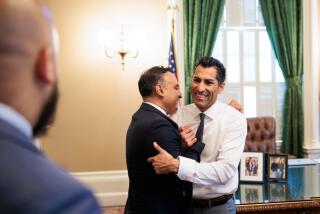13.5 million Californians are covered by Medi-Cal. Here’s how Trump’s plan could cost the state

Medi-Cal enrollment surged by 5 million over the last three years to a total of 13.5 million under President Obama’s Affordable Care Act.
Along with his vow to repeal Obamacare, President-elect Donald Trump has promised to restructure Medicaid, the nation’s low-income health program — a move that could be acutely felt in California, where 1 in 3 residents receive health coverage through the state version, experts say.
Medi-Cal enrollment surged by 5 million over the last three years to a total of 13.5 million under President Obama’s Affordable Care Act.
Some of those Californians could lose portions of their benefits or possibly be dropped from coverage altogether if Trump carries out his plan, which would likely cost the state billions. Even residents who relied on the program long before the current expansion could be affected.
“The cuts in federal funding could be quite significant, and California would have to make a lot of hard choices,” said UC Berkeley Labor Center healthcare program manager Laurel Lucia. “There’s no way California could maintain the program it currently has.”
Under the Affordable Care Act, the federal government offered states money to let more people into their Medicaid programs, which are jointly funded by state and federal governments. California is one of 31 states that took the deal, prompting the Medi-Cal enrollment surge over the last three years.
Now anyone in California can sign up if their annual income is low enough: $16,395 or less for a single person or $22,108 or less for a couple. Medi-Cal is free for participants.
Jason Rector, 32, was able to join Medi-Cal because of the expansion. He’s an actor who juggles part-time jobs so he can still make time for auditions.

“Medi-Cal has been a huge lifesaver for so many of us, because we can pursue what we’re pursuing and not have to have a panic attack if we start to come down with a cold,” said Rector, who lives in Culver City. “It’s just the unknown of what comes next that worries me.”
Experts say that an immediate repeal of the Affordable Care Act is unlikely and that Congress will probably slowly dismantle the law while devising replacement plans. California would lose $15.3 billion in federal funding if the Medicaid expansion is fully undone, according to the state’s Legislative Analyst’s Office.
The Medicaid program in general, which now covers 73 million Americans, has been criticized for being unsustainable and inefficient, with an annual price tag of more than $500 billion and growing. Medi-Cal alone is a $90-billion program, with roughly 65% of that cost shouldered by the federal government.
Under the current funding model for Medicaid, the federal government reimburses states for their programs’ expenses regardless of how big they are. President Johnson created the program in 1965 with this flexible funding model so it could serve as a safety net that could accommodate periods of greater need, such as during economic downturns.
Trump and his pick for secretary of Health and Human Services, Rep. Tom Price (R-Ga.), have said they want to limit spending by giving states a fixed amount of money each year. States will then have an incentive to eliminate fraud, waste and abuse, according to Trump’s website.
But the federal government contribution will probably be less than what states are currently receiving and won’t increase enough over time to keep pace with rising costs, forcing states to either reallocate funds to fill the gap or make cuts, according to a recent Commonwealth Fund report.
“Such a change would effectively reverse a 50-year trend of expanding Medicaid in order to protect the most vulnerable Americans,” the report said.
Dylan Roby, assistant professor of health services administration at the University of Maryland School of Public Health, said California would probably be faced with a multibillion-dollar shortfall too large to fill with state funds.
He said state officials could consider limiting who can join the program and what benefits they receive, areas where California has historically been generous. They could also reevaluate payment rates for doctors, which already took a hit during the recession and are now among the lowest in the nation.
“It just creates more fights around resources at the state level than we currently have,” Roby said.
Roby said Congress could pass changes to Medicaid funding in the first few months of 2017 in a process known as reconciliation, which requires only a simple majority in the Senate. However, the restructuring likely wouldn’t take effect for a few years, he said.
Officials in California say they will fight to keep Medi-Cal as it is, but it’s too early to know what they’ll be faced with.
“There are lots of open questions,” said state Sen. Ed Hernandez (D-West Covina), who chairs that chamber’s health committee. “As long as I’m in the Legislature I will do everything I can to ensure that residents in the state of California have access to healthcare.… It’s inhumane if we put people in the streets without health insurance.”

Pam Gross, 54, has relied on Medi-Cal for decades to afford treatment for lupus and fibromyalgia. She’s worried any changes to Medi-Cal will disrupt her healthcare regimen, which includes several doctors’ appointments each week and treatment from 10
Pam Gross, 54, has relied on Medi-Cal for decades to afford treatment for lupus and fibromyalgia. She’s worried any changes to Medi-Cal will disrupt her healthcare regimen, which includes several doctors’ appointments each week and treatment from 10 specialists.
“I actually talked to my doctors about the whole thing, and I said, ‘OK … what can I go without?’ and they’re like, ‘Nothing,’ ” said Gross, who lives in Carpinteria.
The structural changes to Medicaid would likely also give states more autonomy over their programs, a welcome change for state officials who want to trim benefits or restrict eligibility.
Strict federal laws currently prohibit states from limiting Medicaid enrollment. The state of Montana, for example, wasn’t allowed to make job training classes mandatory for people who signed up for Medicaid.
In a sign of support for loosening these restrictions, Trump chose Seema Verma to head the Centers for Medicare & Medicaid Services. Verma is the architect of an unusual Medicaid expansion model in Indiana — where Vice President-elect Mike Pence was governor at the time — that requires enrollees to pay a small fee to join.
“This idea of fiscal responsibility, but also allowing states to make decisions from a policy perspective about their Medicaid population, that currently isn’t allowed in federal statute,” Roby said.
California, however, has long been committed to providing coverage to as many people as possible without restrictions. The rollout of the Affordable Care Act in California is generally considered a success, with the state cutting its uninsured population by half.
A group of legislators has launched a campaign to extend coverage even further — to immigrants in the country illegally who aren’t allowed to sign up under the law. In one of the movement’s first successes, such immigrants under 19 were able to sign up for Medi-Cal starting in May.
UC Berkeley’s Lucia said that such efforts to further expand coverage could stop if California has to begin considering ways to reduce Medi-Cal spending.
“We have a lot of forward momentum in California, and this really threatens that,” she said.
soumya.karlamangla@latimes.com
Twitter: @skarlamangla
ALSO
These Republicans hate Obamacare, but aren’t ready to give it up just yet
Here are the lies Paul Ryan told about Obamacare during his town hall meeting
More to Read
Start your day right
Sign up for Essential California for news, features and recommendations from the L.A. Times and beyond in your inbox six days a week.
You may occasionally receive promotional content from the Los Angeles Times.







